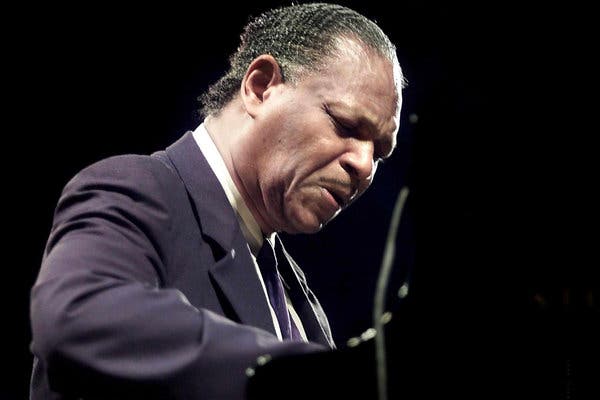Advertisement
Playing with Coltrane and leading his own groups, the pianist’s indelible style stood on its own.

The pianist McCoy Tyner’s impact on music is usually explained through his relationship to John Coltrane, a childhood friend who became his boss in one of the most significant ensembles in American history. But the story of Mr. Tyner, who died on Friday, is also the story of a bandleader and composer whose granite style remained intact even as he tracked the music’s developments, from bebop into free jazz.
By the time he left Coltrane’s group in 1965, Mr. Tyner’s piano had become one of the distinctive forces in jazz: His pot-stirring left hand pounded heavy bass notes, then topped them off with roving stacks of harmony. His right hand’s brisk, zipping phrases made it just as recognizable as the left, if not quite as iconic.
The Coltrane quartet modeled a new kind of ancient thinking about music: as a collective ritual, one that lived by a pledge of mutual independence as well as support. “It is all a matter of giving the soloist more freedom to explore harmonically,” Mr. Tyner said in 1963, when the quartet was in its prime. “Nevertheless, there is a foundation and a point of return. We all know where we are working from.”
From the early 1960s forward, Mr. Tyner also was one of jazz’s most respected bandleaders. He led groups large and small, and penned enough memorable tunes to fill more than one songbook. His influence is written deeply into the generations that have followed him, and into the language of pianists from Mulgrew Miller to Geri Allen. But let’s start with Mr. Tyner’s own output. Below are 11 memorable recordings, from his work as an accompanist and a bandleader.
At age 21, Mr. Tyner joined the quartet of his longtime friend John Coltrane, a kind of elder-brother figure from his adolescent years in Philadelphia. Coltrane by then had nearly exhausted his fascination with corkscrewing harmonic changes, and the group found its identity in a more rooted, incantatory sound, influenced by music traditions from across the globe. With “My Favorite Things,” it also found itself a hit. All of a sudden, Mr. Tyner’s piano was on airwaves across the world, sparring with the drums of Elvin Jones to conjure the special locomotive power that would eventually define the band. Mr. Tyner’s playing on this track is disciplined and neatly contained, but you can easily spot the signature shadings of his harmonies and his trilling ostinatos.
This Tyner original comes from his debut album, “Inception,” released on the then-new Impulse! label, which would become a clearinghouse for the musicians in Coltrane’s orbit. On “Effendi,” named for the noblemen of the Ottoman Empire, Mr. Tyner tags back and forth between a pattern of dancing chords in the right hand and a series of responding melodies in the left, played in unison with Art Davis’s bass. It’s in tune with the hard bop that was lush on the vine in New York then, played by pianists like Elmo Hope and Sonny Clark. But there is a seriousness and a minor-key harmonic language that belong specifically to Mr. Tyner.
Mr. Tyner often spoke of the influence of Bud Powell, the bebop piano pioneer, whom he used to follow around as a young musician in Philadelphia. On “Reaching Fourth,” Mr. Tyner joins up with the drummer Roy Haynes, a veteran of Powell’s ensembles, and the young bassist Henry Grimes, who was on his way to a prominent career in the avant-garde. You can hear Powell’s dashing, bouncing style metabolized inside a music with almost no harmonic movement.
For anyone trying to neatly file Mr. Tyner’s music under “Disposition: Intense,” this is the rejoinder. “Nights of Ballads and Blues” was an album clearly designed to show Mr. Tyner’s gentle side, but he refuses to let the gimmick win. That he can turn a tune as taciturn and eerily beautiful as “’Round Midnight” into a pillowy, Red Garland-like ballad without letting go of its power shows the sensitivity of Mr. Tyner’s ear.
From the time he hit the scene alongside Coltrane, Mr. Tyner was sought by some of the finest young bandleaders, particularly on the Blue Note Records roster. The saxophonist Wayne Shorter was himself a Coltrane acolyte, and he didn’t shy from that affiliation when he made back-to-back albums with Coltrane’s own side musicians. Of course, Mr. Shorter was possessed of his own voice, and on “Juju” his saxophone cast a different shadow on the polyrhythmic structures built by Mr. Tyner and Jones.
On “A Love Supreme,” Coltrane’s magnum opus, the quartet drives its modal approach to a devotional extreme. In the left hand, Mr. Tyner stacked intervals of harmonic fourths, creating the feeling of openness he talked about in that 1963 interview. But in his right hand he worked with a sharp incisor, sculpting shapely phrases with a harmonic specificity of their own. As the musician Sami Linna has pointed out, Mr. Tyner’s right-hand clusters allowed him to imply the harmonic clarity that his left hand eschewed. Rather than unfurling long, droning phrases or centrifugal eruptions, as Coltrane often did, he insisted on compact and lyrical melodies, articulated with a crystalline touch.
The first of seven albums Mr. Tyner would eventually record for Blue Note, “The Real McCoy” is his best-remembered LP. Each of its five original tunes has become more or less a standard. On “Passion Dance,” the album’s hot-blooded opening track, and “Contemplation,” the deep-breathing ballad that follows, Mr. Tyner doubles the melodies with Joe Henderson’s tenor saxophone, while Jones builds a prism of bursting rhythms all around them.
Throughout the 1970s Mr. Tyner continued to expand his ambitions as a composer, while his piano playing made more room for the influence of the avant-garde. On the lengthy live album “Enlightenment,” a highlight from his fruitful years on the Milestone label, his familiar air of focus and intention is preserved — but it’s pervaded by a sense of mutiny and discontent, one that’s reflective of the age. There’s more than one breath-stopping moment on “Presence,” which Mr. Tyner begins and ends with passages of startling polyphony, freely improvising in gusts and riptides, flinging out lines at hyperspeed with only a distant correspondence to one another.
“Asante” is among both the most traditional and the most experimental albums of Mr. Tyner’s career. With an expanded ensemble — percussion, guitar, bass, reeds and voice — he summons a dreamy but vigilant journey. Sometimes he sinks into the kind of syncopated six-beat groove that he and Jones had made into an idiom of its own with the Coltrane quartet. Elsewhere he sticks to a simpler, hypnotic cadence. Throughout, the point is to achieve a full spectrum of sound: This seven-piece band has all the richness and variety of a natural habitat.
In the late 1980s and ’90s, one of Mr. Tyner’s main vessels was his large ensemble, a 15-piece band for which he wrote new works and rearranged items from his back catalog. This reworked version of the Tyner classic “Blues on the Corner” appears on “Journey,” one of three albums that won him Grammys over a span of four years.
The name says it all: This marching, upbeat declaration of a tune — which debuted three decades earlier, on “Enlightenment” — embodies the unity between movement and liberation that’s at the core of Mr. Tyner’s music.
